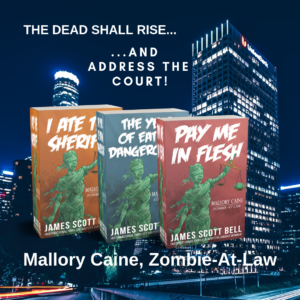by James Scott Bell
@jamesscottbell

Tim Holt, Walter Huston, Humphrey Bogart in The Treasure of the Sierra Madre (1948)
The other day I woke up early, as is my wont, and set about working on my WIP, Romeo #11. The day before I’d finished a scene I loved, and as I looked it over I heard that little voice whispering, “Kill your darlings.” I’ve written about that before. Give a darling a hearing, at least.
The scene ended with action. What I needed now was Mike’s reaction to it. A “sequel” in Dwight Swain terms. Swain was the author of one of the great craft books, Techniques of the Selling Writer. I go over it once a year. Swain held there are two major beats in fiction, scene and sequel. A scene is the action that takes place, with obstacles (conflict) and, in commercial fiction, usually a set-back (he called this a “disaster”). The sequel is the emotional reaction to the disaster, followed by an analysis of the situation and a decision about what action to take next.
It makes sense. When we get slapped down our first reaction is not, “Well now, that was interesting. Let me think about it.” No, we react with raw emotion. The bigger the disaster, the bigger the emotion. Not all setbacks are a 10 on the disaster scale. Sometimes, you don’t need a long sequel. The character can’t find his reading glasses. Darn! That’s sequel enough. But if his wife is blown up by a car bomb (as in the classic film noir The Big Heat) there’s going to be a huge sequel.
You thus render a sequel commensurate with the disaster. If small, you can do it in one line or even one word. Or sometimes skip it and let the action do the talking (He slapped his forehead. And found his glasses).
How you handle scene and sequel determines how your book “feels” to the reader.
The more you emphasize scene, the more you move into the “plot-driven” camp. Some of these have no sequel at all, which makes the books as hardboiled as a twenty-minute egg (see, e.g., the Parker novels of Richard Stark, nom de plume of Donald Westlake).
The more you emphasize sequel, the more you move toward “character-driven” fiction; further still, and you’re closing in on “literary fiction.” Again, these are generalities, but the lesson is clear: the handling of sequel is crucial to the craft.
Indeed, Jim Butcher, author of the Harry Dresden series, is thought of as a plot-driven guy, and not without reason. But he believes sequels “make or break books.”
You’ve got to establish some kind of basic emotional connection, an empathy for your character. It needn’t be deep seated agreement with everything the character says and does–but they DO need to be able to UNDERSTAND what your character is thinking and feeling, and to understand WHY they are doing whatever (probably outrageous) thing you’ve got them doing. That gets done in sequels.
His breakdown:
1) Scene–Denied!
2) Sequel–Damn it! Think about it! That’s so crazy it just might work!–New Goal!
3) Next Scene!
Repeat until end of book.
Now, my Mike Romeo books are not, by intention, purely hardboiled. I think about sequels a lot.
And that’s where I was on the morning in question. I needed a sequel to the action. But what should it consist of?
Here’s a secret: don’t just grab the first emotion that comes to mind. That’s usually the one readers expect. Avoiding the predictable is essential to page-turning fiction.
So there I was, in Scrivener, wondering what Mike’s reaction should be. So in the notes section, I started writing…and writing….in Mike’s voice….until he started telling me something I hadn’t anticipated. Boom! There it was, the right sequel.
When I get to a moment of big emotion, I usually open up a fresh text doc, or use the Scrivener notes panel, and overwrite, just letting the words pour out until I get to a fork in the road and, like Yogi Berra used to counsel, take it. I write metaphors in fast bunches, like candies on the conveyor belt in that famous I Love Lucy episode. (“Speed it up a little!”).
I’ll write 200, 300 words. And then I pan for gold. Even if it’s just one line that sparkles, I’ll polish it up and use it. This is the “work” of a writer, which some sniff at as being too much effort. I choose to go for the gold.
How about you?


 What’s wrong with this sentence, from an old pulp novel:
What’s wrong with this sentence, from an old pulp novel: The other morning, as is my wont (and I want what I wont when I want it) I took a fresh cup of joe and my AlphaSmart to the backyard for some thinking, pondering, and writing time. The joe was brewed in my moka pot, a gift to mankind from the Italian inventor Alfonso Bialetti. Usually I take it black, but we happened to have some Coffeemate Sweet Italian Cream in the fridge. I thought the key word was Italian, but as it turns out the emphasis should be on sweet. This stuff is a sugar bomb. You need less than a dollop of regular cream. My hand trembled, and I poured in a touch too much.
The other morning, as is my wont (and I want what I wont when I want it) I took a fresh cup of joe and my AlphaSmart to the backyard for some thinking, pondering, and writing time. The joe was brewed in my moka pot, a gift to mankind from the Italian inventor Alfonso Bialetti. Usually I take it black, but we happened to have some Coffeemate Sweet Italian Cream in the fridge. I thought the key word was Italian, but as it turns out the emphasis should be on sweet. This stuff is a sugar bomb. You need less than a dollop of regular cream. My hand trembled, and I poured in a touch too much.